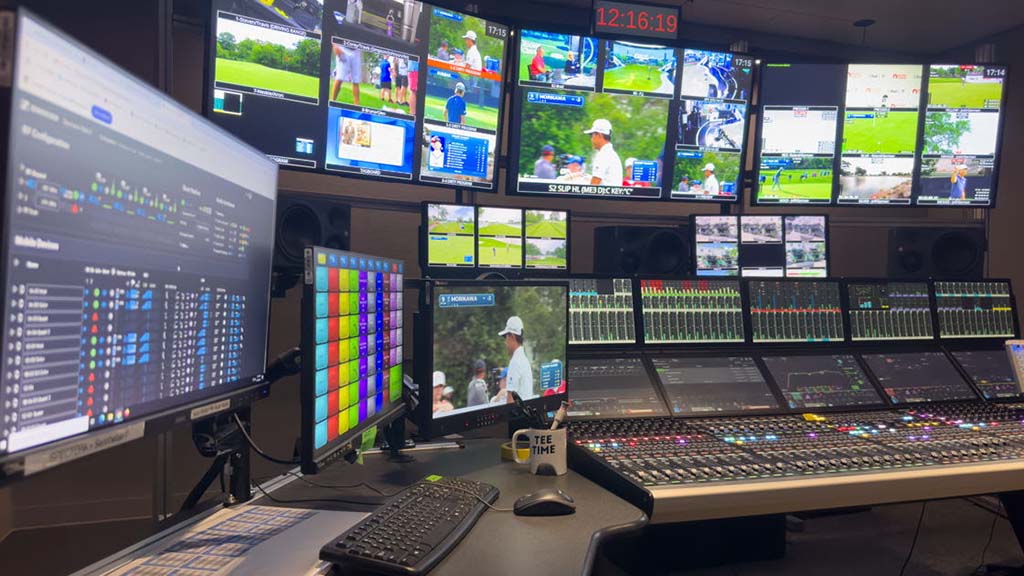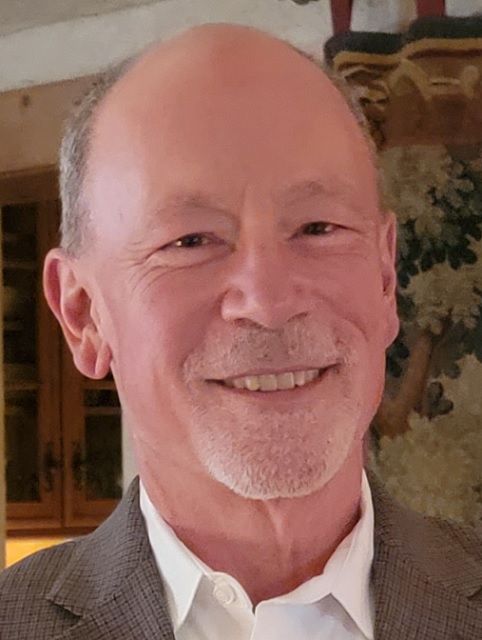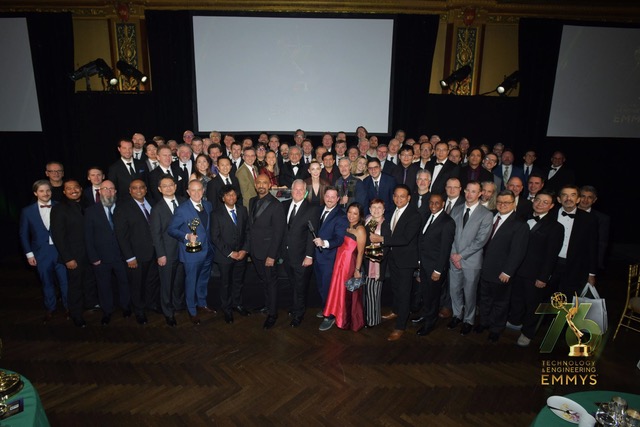PGA Tour Studios Deploys Sennheiser Spectera Wireless Audio System at New Campus
Combines microphones, IFBs and control data on a single wideband RF channel

PONTE VEDRA BEACH, Fla.—PGA Tour Studios has deployed the new Sennheiser Spectera bidirectional wireless audio ecosystem across its new campus here.
Responsible for extensive live PGA Tour coverage and diverse studio shows, the PGA Tour Studios audio team required a system that could support a state-of-the-art facility with seven dedicated studios and manage up to 11 shows broadcasting at the same time in an environment packed with competing RF signals.
PGA Tour Studios needed a wireless solution that could keep pace with the demands of a fast-moving, multistudio production environment. Spectera emerged as the best choice due to its technical capabilities as well as how it simplified installation and allowed the engineering team to focus on production rather than infrastructure.
The new system needed to offer effortless transitions between studios and a dramatically simplified management interface. The PGA Tour chose Spectera, Sennheiser’s wideband, bidirectional wireless ecosystem, the company said.
Seamless Integration
Unlike traditional wireless audio setups, Sennheiser said, Spectera doesn’t rely on a complex mix of separate systems for microphones and in-ear monitors or interruptible foldback (IFB) monitors—each on its own frequency and requiring channel and guard band planning.
Spectera combines microphones, IFBs and control data on a single wideband RF channel, managed from a compact 1 rack-unit base station. This fundamentally simplifies the handling of wireless audio in live production. PGA Tour Studios strategically implemented Spectera as the backbone audio infrastructure of its new campus.
“Our original vision was to implement a building-wide RF system that offered seamless coverage across all studios, regardless of location,” Ricardo Landaeta, manager of audio broadcast for the PGA Tour, said. “We have seven studios, each with three or four talents, and our goal is to run six shows weekly with a maximum of four talents per show, operating four days a week for 12 hours. Resilience, quality and versatility are important. With Spectera, talent can easily transition between studios by simply grabbing a pack, and guest integration is smooth.”
The professional video industry's #1 source for news, trends and product and tech information. Sign up below.
Spectera’s breakthrough runs both microphone and IFB channels together in the same centrally managed 6 or 8 MHz of bandwidth. Up to 64 audio channels (32 in, 32 out) can be handled from a single rack unit, something previously requiring a tangle of receivers, transmitters and careful manual frequency calculations.
The bidirectional SEK bodypacks operate as a mic or line transmitter and an IFB receiver at once, reducing gear and cabling for everyone on stage. Operators are also able to monitor and control packs remotely, leveraging Spectera’s continuous two-way link, the company said.
“It’s rewarding to see the system commissioned and performing precisely as Ricardo and his team envisioned,” Valerie Seward, broadcast engineer at PGA Tour Studios, said. “We’re managing up to 10 shows concurrently, and engineering has enabled talents to work across multiple studios without impacting audio quality. Our main goal was to deliver a pristine audio environment and foster clear communication for our talents, and we’ve achieved and exceeded that goal without needing any backend changes.”
The setup includes two Spectera base stations supporting 24 microphones and IFB monitors, distributed across the facility with seven dedicated antennas to ensure optimal coverage. There are plans for this setup to be expanded to six base stations and additional packs in fall of 2025, providing building-wide coverage and hardware redundancy, it said.
The infrastructure cost savings were an important factor in selecting Spectera. The system does not rely on RF-over-fiber converters, combiners and amplifiers, or ¾-inch RF cable, all of which add large overhead to the cost of the system. In the case of Spectera, base stations are connected to antennas using standard Ethernet cables, and the antennas are POE (Power over Ethernet), further simplifying the setup, it said.
“The commissioning process was remarkably swift and straightforward,” said Joel Latimer, audio engineer A1 at PGA Tour. “It took just 10 minutes to turn it on, set it up and showcase what it can do. The ease of use took all of us pleasantly by surprise.”
This rapid deployment allowed the system to go live quickly. After two weeks of extensive testing completed in early January, PGA Tour Studios fully deployed Spectera, actively supporting on-air broadcasts across four studios.
Streamlined Workflow
For PGA Tour Studios, Spectera demonstrated its RF resilience and stability, even in demanding broadcast environments. During times of heightened activity, such as The Players Championship, the campus is surrounded by a massive truck compound generating a large amount of external RF signals. Despite these difficult conditions and numerous internal shoots occurring at the same time, the Spectera system did not experience a single dropout, hit or interference issue, Sennheiser said.
The system’s simplicity has streamlined PGA Tour Studios’ workflow. Talent can move between different studios without worry, pick up any available pack and immediately be operational without the need for any backend reconfigurations or manual adjustments.
Engineers can swap out depleted batteries during live broadcasts, significantly cutting down on delays to production. The process of going live again after a battery swap now takes 7 seconds. Spectera integrated with PGA Tour Studios’ existing Dante and Calrec 2110 audio environments, ensuring that even with signal conversion occurring, there was no discernible delay or compromise in audio, it said.
“Our expectations for stability have been met even with other studios and activities happening around us,” Latimer said. Battery life has also been surprisingly good—we’ve even seen packs last up to seven hours on new batteries. The key is that we want everything to run smoothly, and nothing has gone wrong.
“We really like the software as well; it provides a fantastic visual reference for everything that’s happening with each pack,” Latimer continued. “Especially when mixing a show, we can quickly check the band RF levels. If there’s any signal loss, we can immediately identify it and communicate with engineers to allocate resources. Spectera is incredibly intuitive.”
The PGA Tour Studios audio team has set up Spectera in such a manner that it can have access to all base stations from all computers around the facility. Using Spectera WebUI for each base station, the team can continuously monitor the health of microphones, IEMs/IFBs and antennas, as well as critical battery and RF levels. The audio team can log into any base station from anywhere on the network as needed enabling the team to be proactive in its management to prevent surprises and ensure system integrity, it said.
Spectera’s versatility makes it integral to a vast array of PGA Tour Studios’ productions. It’s consistently used across coverage of numerous live tournaments, including four streams for PGA Tour Live on ESPN+, PGA Tour Champions and Korn Ferry Tour on Golf Channel. It is also the core system for popular studio shows including “The Drop” on Golf Channel, “On the Range” on Golf Channel and YouTube and the “Creator Classic Series presented by YouTube.”
More information is available on the Senneheiser website.
Phil Kurz is a contributing editor to TV Tech. He has written about TV and video technology for more than 30 years and served as editor of three leading industry magazines. He earned a Bachelor of Journalism and a Master’s Degree in Journalism from the University of Missouri-Columbia School of Journalism.

